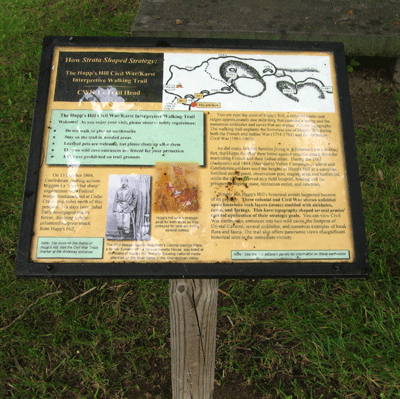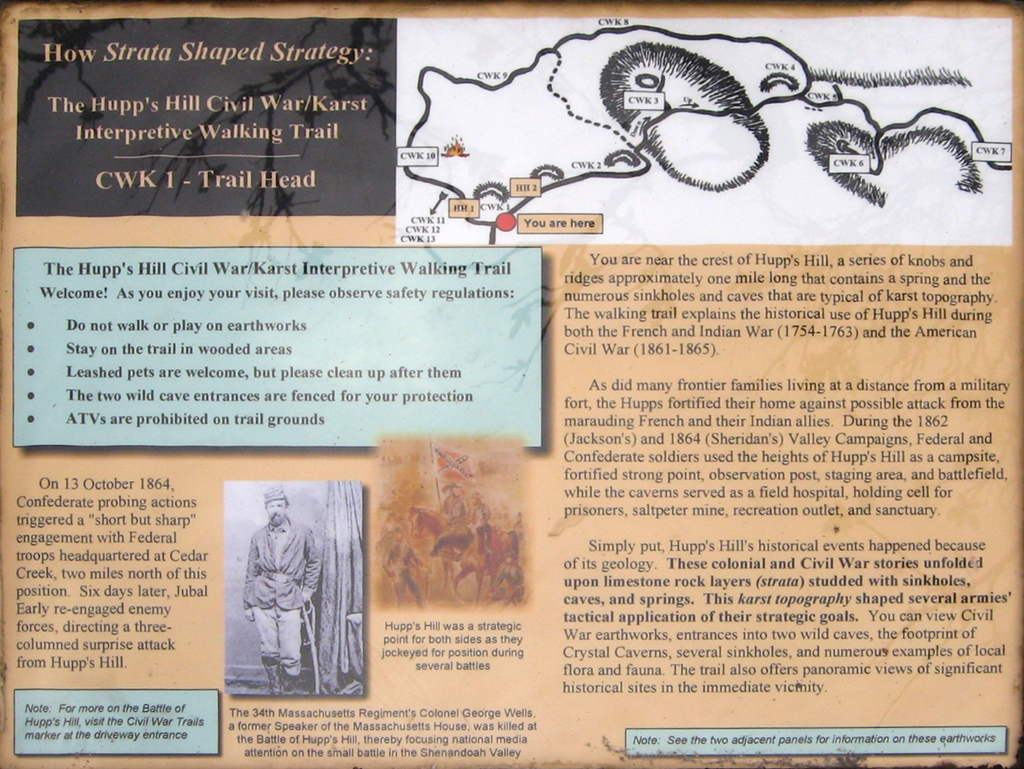Strasburg > Hupp’s Hill Civil War/Karst interpretive walking trail
The Trail Head marker for the Hupp’s Hill Civil War/Karst Interpretive Walking Trail is at the parking lot at the Hupp’s Hill Civil War Park north of Strasburg, Virginia.

From the marker
How Strata Shaped Strategy:
The Hupp’s Hill Civil War/Karst
Interpretive Walking Trail
CWK – 1 Trail Head
The Hupp’s Hill Civil War/Karst Interpretive Walking Trail
Welcome!
As you enjoy your visit, please observe safety reguations:
– Do not walk or play on earthworks
– Stay on trail in wooded areas
– Leashed pets are welcome, but please clean up after them
– The two wild cave entrances are fenced for your protection
– ATVs are prohibted on trail grounds
On 13 October 1864, Confederate probing actions triggered a “short but sharp” engagement with Federal troops headquartered at Cedar Creek two miles north of this position. Six days later, Jubal Early re-engaged enemy forces, directing a three-columned surprise attack from Hupp’s Hill.
You are near the crest of Hupp’s Hill, a series of knobs and ridges approximately one mile long that contains a spring and the numerous sinkholes and caves that are typical of karst topography. The walking trail explains the historical use of Hupp’s Hill during bith the French and Indian War (1754-1763) and the American Civil War (1861-1865).
As did many founder families living at a distance from a military fort, the Hupps fortified their home against possible attack from the marauding French and their Indian alies. During the 1862 (Jackson’s) and 1864 (Sheridan’s) Valley Campaigns, Federal and Confederate soldiers used the heights of Hupp’s Hill as a campsite, fortified strong point, observation post, staging area, and battlefield, while the cave served as a field hospital, holding cell for prisoners, saltpeter mine, recreation outlet, and sanctuary.
Simply put, Hupp’s Hill’s historical events happened because of its geology. These colonial and Civil War stories unfolded upon limestone rock layers (strata) studded with sinkholes, caves and springs. This karst topography shaped several armies’ tactical applcation of their strategic goals. You can view Civil War earthworks, entrances into two wild caves, the footprint of Crystal Caverns, several sinkholes, and numerous examples of local flora and fauna. The trail also offers panoramic views of significant historical sites in the immediate vicinity.
Note: For more on the Battle of Hupp’s Hill, visit the Civil War Trails marker at the driveway entrance.
Note: See the two adjacent panels for information on these earthworks.
Photo Captions:
The 34th Massachusetts Regiment’s Colonel George Wells, a former Speaker of the Massachusetts House, was killed at the Battle of Hupp’s Hill, thereby focusing national media attention on the small battle in the Shenandoah Valley.
Hupp’s Hill was a strategic point for both sides as they jockeyed for position during several battles.

